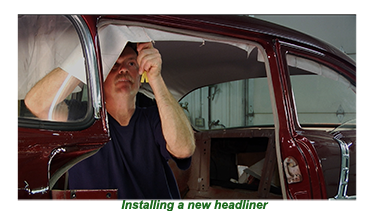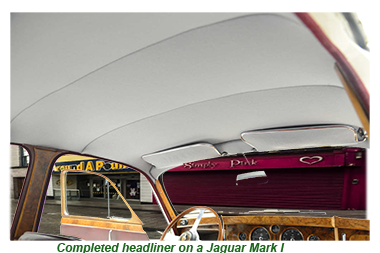 Among the numerous challenges that need to be addressed during a classic car restoration project, the task of refurbishing the headliner is often overlooked and given lower priority.
Among the numerous challenges that need to be addressed during a classic car restoration project, the task of refurbishing the headliner is often overlooked and given lower priority.
Typically located in the background, despite its subtle presence, the headliner serves an important role by providing overhead illumination.
When evaluating a classic car for restoration, it is highly probable that the headliner, if extensively damaged, will require repair or even replacement.
Alternatively if the restorer gets lucky, the only issue they may encounter is the discoloration of the headlining , usually caused by a significant accumulation of nicotine.
During the Fifties and Sixties, it was common for both drivers and their passengers to smoke cigarettes and sometimes even pipes, much more compared to the present day.

 If the vehicle owner did not smoke in the car, and prevented his passengers from doing so, the chances are that the cloth will be in salvageable condition, even if it is stained with nicotine. All that will be required is a high-quality carpet or upholstery cleaner.
If the vehicle owner did not smoke in the car, and prevented his passengers from doing so, the chances are that the cloth will be in salvageable condition, even if it is stained with nicotine. All that will be required is a high-quality carpet or upholstery cleaner.
It is highly probable that a few tears may be found in the headliner.
If the tears are not too severe, they can be repaired by sewing them together using a circular upholsterer's needle. However, if the tear is more serious or widespread, the most practical solution would be to replace the old headlining with a new one.
 It is crucial to exercise utmost caution while removing the previous lining. This is to ensure that the material remains intact and undamaged, as it serves as a valuable template for the replacement process.
It is crucial to exercise utmost caution while removing the previous lining. This is to ensure that the material remains intact and undamaged, as it serves as a valuable template for the replacement process.
 The lining is typically fastened to the roof using strips of fabric called "lists".
The lining is typically fastened to the roof using strips of fabric called "lists".
In vintage automobiles, the roof lists were commonly affixed to wooden roof rails. However, for vehicles manufactured during the Fifties and Sixties, the lists would typically be fastened to a metal bar inserted through the list and secured to the roof using screws or clips.
To effectively remove the tacks securing the metal bar, it is necessary to utilise either a tack remover tool or, alternatively, a chisel and mallet can be used as a suitable substitute.
 The initial step involves removing the double piping that surrounds the finishing line. Next, it is important to release all the tacks around the edge of the lining, starting from the nearside front. Once this phase of the operation has been successfully executed, the lists will exclusively retain the lining in its designated position.
The initial step involves removing the double piping that surrounds the finishing line. Next, it is important to release all the tacks around the edge of the lining, starting from the nearside front. Once this phase of the operation has been successfully executed, the lists will exclusively retain the lining in its designated position.
If the lists are secured by tacks, they should be carefully removed, starting from the front of the car. If the lining of a vehicle is secured by metal roof bars, it is necessary to unscrew or unclip them in a specific order. Once they are removed, it is advisable to roll them up in the cloth for safekeeping.
Once the lining has been fully rolled back, the rear curtain can be easily removed. To accomplish this task, one can begin by removing the tacks surrounding the rear window, followed by the side windows. Next, the bottom finishing line should be released, and finally, the top one can be detached.
 Once the lining has been removed from the car, it is important to address any potential rust that may have developed.
The initial step involves the application of a rust-preventing agent, followed by the subsequent application of anti-rust paint to the affected area.
Once the lining has been removed from the car, it is important to address any potential rust that may have developed.
The initial step involves the application of a rust-preventing agent, followed by the subsequent application of anti-rust paint to the affected area.
During the removal of the cover, it is advisable to take advantage of this opportunity to replace the interior light flex. Over time, the flex is prone to deterioration and may even have perished.
 If certain tack rails have not held up well, it is advisable to replace them.
If certain tack rails have not held up well, it is advisable to replace them.
 After completing the necessary background work, the subsequent step involves selecting the most suitable material for constructing the headlining.
After completing the necessary background work, the subsequent step involves selecting the most suitable material for constructing the headlining.
Headliners are available in a range of materials to accommodate different preferences and requirements. These options include recovering the existing headliner, replacing the headliner while keeping the current board, or opting for a complete replacement.
A guide to acquiring, restoring and maintaining UK or European Classic Cars of the Fifties and Sixties- as well as a recollection of the iconic cars of the era and the visionaries that produced them.
Take me back to the home page.
cu2

